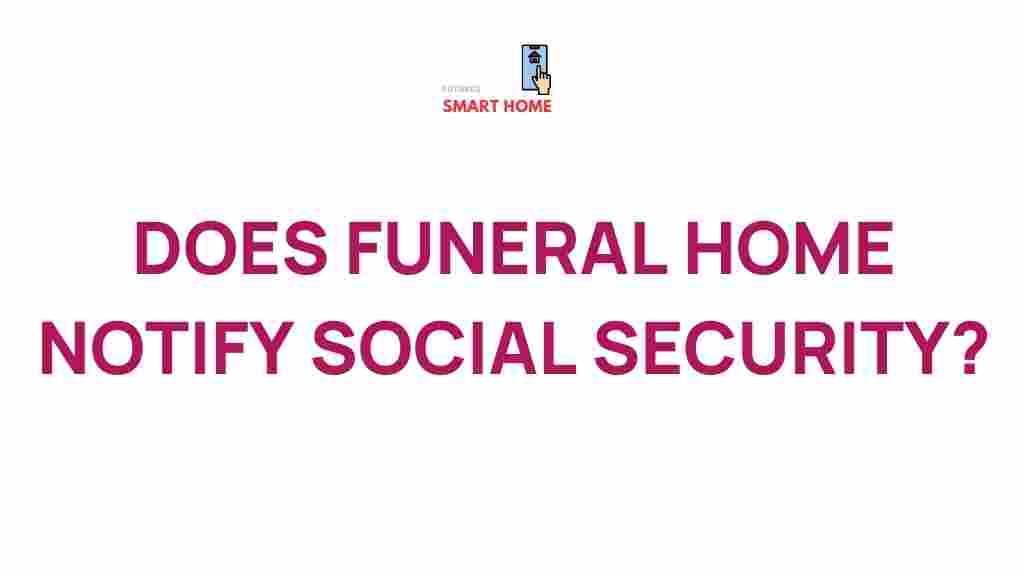Unveiling the Intriguing Process: How Do Funeral Homes Notify Social Security?
The passing of a loved one is undoubtedly a challenging time filled with grief and numerous responsibilities. One crucial aspect that families often overlook during this period is the notification process to Social Security. Understanding how funeral homes manage this process can ease some of the burdens during such a difficult time. In this article, we will delve into the intricacies of how funeral homes notify Social Security about a deceased individual, the benefits that may be available to the family, and the relevant government regulations.
Understanding the Role of Funeral Homes
Funeral homes play a vital role in assisting families after the death of a loved one. They are responsible for managing the logistics of the funeral service, including:
- Preparing the body for burial or cremation
- Coordinating with cemeteries or crematories
- Providing emotional support to grieving families
- Handling paperwork, including death certificates
Among these responsibilities is the significant task of notifying Social Security about the death of an individual. This notification process is essential for stopping any future payments and for initiating potential benefits for survivors.
The Notification Process Explained
When a person passes away, the funeral home typically initiates the notification process to Social Security. Here’s a step-by-step breakdown of how this process works:
Step 1: Gathering Necessary Information
Upon the passing of an individual, the funeral home will first collect the necessary information, which includes:
- The deceased’s full name
- Date of birth
- Date of death
- Social Security number
- Address at the time of death
- Names of surviving family members
This information is crucial for the funeral home to file the notification accurately.
Step 2: Completing the Death Certificate
Next, the funeral home assists the family in completing the death certificate. This document is essential not only for legal purposes but also for the Social Security notification process. The death certificate must be signed by a medical professional, usually a doctor, who can confirm the cause of death. Once completed, the funeral home will file the death certificate with the appropriate state office.
Step 3: Notifying Social Security
After filing the death certificate, the funeral home will contact the Social Security Administration (SSA) to notify them of the deceased. This can typically be done in the following ways:
- Online through the SSA’s website
- By phone
- By mail, sending the information directly to the local SSA office
This notification is crucial as it ensures that no further benefits are issued to the deceased and that any outstanding benefits can be processed for eligible survivors.
Step 4: Confirming Notification
After the funeral home has submitted the notification, they may follow up with the SSA to confirm that the notification has been received and processed. This can provide peace of mind to the family, knowing that the necessary steps are being taken.
Benefits and Regulations
Notifying Social Security is not just about stopping payments; it also opens the door for certain benefits for surviving family members. Here’s a look at some benefits that may be available:
- Survivor Benefits: Eligible surviving spouses or children may receive monthly benefits based on the deceased’s earnings.
- Death Benefits: A one-time lump sum payment (currently $255) may be available to the spouse or child of the deceased.
It’s important to be aware of the regulations surrounding these benefits, which can vary based on individual circumstances. Families should consult with the SSA or a financial advisor to understand what they might be entitled to.
Troubleshooting Common Issues
While the notification process is straightforward, there can be complications. Here are some common issues and how to address them:
Issue 1: Delayed Death Certificate
If there is a delay in obtaining the death certificate, the funeral home can assist in expediting the process by ensuring all necessary documentation is complete and filed promptly.
Issue 2: Incorrect Information
Errors in the notification to Social Security can lead to complications. If a family notices an error in the submitted information, they should contact the funeral home immediately to rectify it. The funeral home can then reach out to the SSA to correct any inaccuracies.
Issue 3: Unawareness of Benefits
Families may not be aware of the benefits they are entitled to receive. Consulting with the funeral home or contacting the SSA directly can provide clarity on available benefits and the application process.
Conclusion
The process of notifying Social Security after the death of a loved one is an essential step that can often be overlooked amidst the grief of losing someone. Understanding how funeral homes manage this notification process can help families navigate this challenging time with greater ease. By ensuring that all necessary information is collected, the death certificate is filed, and notifications are made, funeral homes play a crucial role in this process. Additionally, being aware of the potential benefits available to surviving family members can alleviate some financial burdens during a difficult period.
As families face the complexities of loss, working closely with a funeral home can provide the necessary support and guidance. For more information about funeral services and the benefits available, consider visiting this helpful resource. To learn more about Social Security benefits and regulations, check out the official Social Security Administration website.
This article is in the category News and created by FutureSmarthome Team
